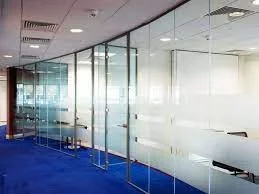
Smart Glass
Smart Glass, also called smart privacy glass or smart glass window, represents the coming position in glass technology, offering users dynamic control over the translucency, shade, and sequestration of glass surfaces. This innovative glass can seamlessly switch between clear and opaque countries with simple control, creating a protean result for colourful operations, from home innards to commercial settings. Unlike traditional glass, Smart Glass is adaptable and responsive, designed to meet the growing demand for sequestration, light operation, and energy effectiveness in colourful surroundings. Whether used as windows, partitions, or doors, Smart Glass can incontinently transfigure a space by regulating the quantum of light and visibility, adding a subcaste of complication and functionality that complements ultramodern armature.
At its core, Smart Glass uses technical technology—either in response to an electric current or environmental factors like temperature—to modify its appearance. When actuated, Smart Glass can acclimate its nebulosity, allowing users to control sequestration and lighting grounded on their immediate requirements. This inflexibility makes it an ideal choice for places, services, healthcare installations, and hospices, enhancing both aesthetics and functionality. As technology advances, Smart Glass is fleetly becoming a favoured option for those seeking ultramodern, adaptable design rudiments in their living and working spaces.
How Does Smart Glass Work?
Smart Glass technology functions by modifying the transparency, hue, or translucence of glass grounded on external factors similar as electricity, temperature, or light exposure. This technology allows windows, doors, and partitions to switch between clear and opaque or tinted countries, furnishing sequestration, light operation, and energy effectiveness.
Here’s how Smart Glass works in general terms:
-
Electrically Controlled Opacity
In most Smart glasses, electric currents are used to shift particles or ions within the glass layers, creating changes in transparency or color. When an electric charge is applied, it triggers the particles or ions to align or disperse, which changes the glass’s appearance. For example, when the current flows through the glass, it might become clear, allowing light to pass through.
-
Particle Suspension and Alignment
Another mechanism involves suspending microscopic particles within a special layer. When an electric charge is introduced, these particles align in a way that controls the amount of light passing through the glass. This approach allows for precise control over light and heat, making it ideal for situations requiring variable shading, such as reducing glare or heat from sunlight.
-
Temperature Response
Some Smart Glass works without electricity by reacting to temperature changes. Known as thermochromic glass, this type darkens when exposed to heat, automatically reducing sunlight penetration and helping with passive solar control.
-
Switching Mechanisms
In many applications, Smart Glass can switch states nearly instantaneously. For example, the glass can transition from transparent to opaque in less than a second, offering on-demand privacy for spaces like meeting rooms, bathrooms, or home windows.
The technology behind Smart Glass thus offers flexibility, efficiency, and privacy by adjusting transparency based on user preference or environmental needs, making it a highly adaptable solution for modern architectural and interior design.
Types of Smart Glass
Smart Glass operates using various advanced technologies that are acclimatized to different user requirements and environmental factors. These types include electrochromic, liquid crystal (LC), suspended particle device (SPD), and thermochromic Smart Glass, each immolation with unique functionality and benefits.
● Electrochromic Smart Glass
Electrochromic glass adjusts its nebulosity when a low electrical voltage is applied. This change happens gradationally, allowing users to shift the glass from clear to bepainted without abrupt transitions. This type is ideal for settings where gradational control over light and sequestration is essential, similar to office windows or private places.
● Liquid Crystal (LC) Smart Glass
LC Smart Glass is known for its rapid-fire nebulosity switch, making it a great option for spaces demanding instant sequestration. In this type, liquid chargers are suspended within layers of glass. When actuated by an electric current, the chargers align to make the glass transparent; when turned off, it turns opaque. This point makes LC Smart Glass popular for places like meeting apartments or restroom windows, where sequestration on demand is precedence.
● Suspended Particle Device (SPD) Smart Glass
SPD Smart Glass consists of light-blocking patches that come systematized and aligned when a voltage is applied, allowing users to acclimate the glass to darker countries that control light and heat from sun. This type is perfect for areas with high sun exposure, as it provides effective light and heat operation, making it energy-effective and suitable for warm climates.
● Thermochromic Smart Glass
Thermochromic glass does not calculate electricity but responds to changes in temperature. As temperatures increase, the glass gradually darkens to control light and heat passively. This type of Smart Glass is generally used outside or in spaces where a natural response to heat is desirable, adding convenience with energy effectiveness for sun exposure.
Applications of Smart Glass
The versatility of Smart Glass allows it to be used across a variety of settings, from domestic to marketable. Each type of Smart Glass technology can be named and customized according to the functional and aesthetic requirements of the space.
-
In Homes
Smart Glass is popular for windows, yard doors, and indeed partitions within open bottom plans. It provides malleable sequestration and natural light operation without the need for curtains or hangouts, enhancing both design and comfort.
-
Office Spaces
Office spaces profit from Smart Glass in meeting apartments and partitions, offering sequestration while creating an open, flexible work terrain. By reducing light and controlling natural light, it also improves energy effectiveness and hand comfort.
-
Healthcare Facilities
In healthcare installations, Smart Glass enhances sequestration in case apartments and reduces the need for traditional hangouts, which are prone to collecting dust and origins. This enhancement in cleanliness and sequestration makes it a popular choice in hospitals and conventions.
Benefits of Smart Glass
Smart Glass offers multitudinous benefits, enhancing both functionality and aesthetics across colorful operations. By enabling light and sequestration situations to be easily controlled, Smart Glass improves energy effectiveness, reduces light, and provides customizable sequestration. Its rigidity means that spaces can be converted at the touch of a button, making it ideal for services, homes, and healthcare installations. Also, its energy-saving capabilities make it a sustainable choice, as it helps to reduce heating and cooling costs by controlling sunlight and heat transfer.
Installation Process of Smart Glass
The installation of Smart Glass requires professional expertise to ensure optimal performance. It involves integrating the Smart Glass with electrical systems, as well as ensuring proper sealing and sequestration. Trained professionals handle the installation, from preparing the glass panels to configuring control systems that allow easy operation of the glass's translucency and privacy features. Residential Coating Solutions provides comprehensive installation services, ensuring that the process is effective, flawless, and acclimatized to your specific conditions.
Cost Considerations for Smart Glass
The cost of Smart Glass depends on several factors, including the type of technology used, the size of the installation, and customization conditions. While it can represent a advanced outspoken investment compared to traditional glass, the energy savings, sequestration control, and enhanced design make it a precious long- term investment.
Smart Glass pricing varies depending on the size, type, and specific installation conditions. At Residential Coating Results, we offer competitive pricing that is acclimatized to meet different design requirements. Our experts will work with you to understand your conditions, budget, and vision, furnishing a transparent pricing structure and helping you make an informed investment in Smart Glass technology.
Future of Smart Glass Technology
The future of Smart Glass technology is promising, with ongoing advancements anticipated to make it even more effective, affordable, and versatile. Experimenters are working on inventions that ameliorate the responsiveness and energy effectiveness of Smart Glass, potentially barring the need for external power sources altogether. These advancements will probably expand Smart Glass operations, making it an essential element in sustainable and energy-effective structure designs.
Why Choose Residential Coating Solutions for Smart Glass?
Choosing Residential Coating Solutions means choosing quality, moxie, and trustability. Our team specializes in Smart Glass installations, delivering customized results that fit both domestic and marketable requirements. With our commitment to excellence, we provide end-to-end service from discussion and design to installation and aftercare. We ensure that each design reflects our high norms, giving you peace of mind and a space converted by the latest in Smart Glass technology.
Ready to transfigure your space with Smart Glass?
Contact Residential Coating Solutions today for a discussion and discover how Smart Glass can review your terrain with style, privacy, and energy effectiveness.
FAQs about Smart Glass
1. What is Smart Glass?
Smart Glass is an advanced type of glass that allows users to control its translucency, offering adaptable sequestration and light operation for colourful settings.
2. How does Smart Glass work?
Smart Glass works through technologies like electrochromic, liquid crystal, SPD, and thermochromic systems, each responding to electrical or environmental changes to acclimate nebulosity and light transmission.
3. Where can Smart Glass be used?
Smart Glass is versatile and can be used in homes, services, healthcare installations, and hospitality spaces for windows, doors, partitions, and more.
4. Is Smart Glass energy-effective?
Yes, Smart Glass improves energy effectiveness by controlling heat and light transfer, helping reduce heating and cooling costs.
5. How much does Smart Glass cost?
The cost of Smart Glass varies based on the type, size, and customization needed. Contact Residential Coating Solutions for acclimatized quotations.




